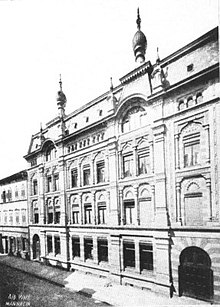Lemle-Moses-Claussynagoge
The Lemle-Moses-Klaus was a Talmud school with a synagogue , which existed from 1708 in square F1, 11 in Mannheim city center . From the 19th century onwards it was often simply called the Klaussynagoge . It served as a sacred building until 1940.
history
The synagogue was named after Lemle Moses Reinganum (1666-1724), a Jewish court and senior militia factor from Rheingönheim and head of the Jewish community in Mannheim. In 1706 he founded a Klaus , i.e. a Talmud school with synagogue, which was inaugurated in September 1708. Reinganum endowed the Klaus Foundation with 100,000 guilders, which were invested in Darmstadt. The annual interest payments at a rate of 6 percent should finance the operation. In the middle of the 18th century, the payments, which were subject to the arbitrariness of the Hessian landgrave , were slow. Elias Hayum , like Reinganum a Palatine court factor and head of the Jewish community, secured the continued existence of the foundation with a large donation and thus became the second major benefactor.
In 1794 a fire destroyed the teaching house and the library and caused serious damage to the synagogue. The reconstruction was completed in May of the following year. From 1855, when the new main synagogue was built, the Klaussynagoge served as the center of the Orthodox Jews , who rejected the reform service . From 1887 the old Klaus was replaced by a new building based on plans by the Mannheim architect Wilhelm Manchot (1844–1912). The inauguration could be celebrated on November 29, 1888. In 1929/30 another major renovation took place under the direction of the architect Siegfried Seidemann .
The sacred building was desecrated during the pogrom from November 9th to 10th, 1938. To Passover 1939, the synagogue was restored makeshift and served from now on the services of the entire Jewish community of Mannheim . On October 22, 1940, almost all Mannheim Jews, around 2,000, were deported to the French concentration camp Camp de Gurs during the “ Wagner-Bürckel Action ” . During the Second World War, the building was destroyed by bombs. The property was sold by the Jewish Restitution Successor Organization (JRSO) after the war and the ruins were demolished in 1953.
On the 60th anniversary of the pogrom night, a memorial plaque was put up on F1, 7 in 1998. Another plaque in front of the new synagogue in F3 has been reminding of the Lemle-Moses-Klaus since 2007.
description
The Klaus consisted of a complex of several buildings. The main entrance was in the south of the square in F1, 11 on the so-called Fressgass'. Another access was possible from the eastern Breiten Straße via F1, 2. The synagogue was in the courtyard behind the block perimeter development . The new building was built in 1887 in F1, 11 in the Moorish style as a three-and-a-half-storey, wide building with a high hipped roof with a high drum dome that was not visible from the outside. The five-part facade was nine-axis. Two side projections , bordered at the corners with pilaster-like pilaster strips , had a segment-arched upper end and small domes. The domed side projections divided the extra-wide facade into a three-axis central wing and two side wings.
In plan, the synagogue was a central building with side wings with galleries for the female worshipers. After the expansion in 1929/30, the prayer room was 12 meters wide and 20.5 meters long. The interior design of the building was also striking, as the masonry was horizontally striped. The windows had a horseshoe shape and were hidden behind a blind arch , which had either lobed arches in the style of the Alhambra or curved, pointed arches in the style of an Indian mosque .
See also
literature
- Hans Huth: Die Kunstdenkmäler des Stadtkreis Mannheim Vol. 1. Deutscher Kunstverlag, Munich 1982, ISBN 3-422-00556-0 , p.
- Volker Keller: The Klaus Synagogue in Mannheim. On the history of the Lemle-Klaus Foundation, in: Mannheimer Hefte 1, 1984, pp. 32–53.
- Karl Otto Watzinger : History of the Jews in Mannheim 1650-1945 . Stuttgart 1984, ISBN 3-17-008696-0 .
- Volker Keller: Jewish life in Mannheim . Mannheim 1995, ISBN 3-923003-71-4 .
- Britta Waßmuth: In the field of tension between court, city and Jewish community. Social relations and mentality change among court Jews in the Palatinate residence city of Mannheim at the exit of the Ancie Régime . Ludwigshafen am Rhein 2005, ISBN 3-934845-30-4 .
- Volker Keller (ed.): The world of the Mannheimer Klaus. Teaching house and synagogue in three centuries . Texts by Lena Baum, Vera Bendt, Max Gruenewald, Leopold Göller, Jack J. Goldman, Volker Keller, Chaim Lauer, Helwine Lindmann, Julius Moses, Eugen Neter, Berthold Rosenthal , Schlomo Rülf, Siegfried Seidemann, Isak Unna, Viktor Unna. Waldkirch publishing house, Mannheim 2012, ISBN 978-3-86476-016-7 [1] .
- Christiane Twiehaus: Synagogues in the Grand Duchy of Baden (1806-1918). A study of their reception in the public media Universitätsverlag Winter, Heidelberg 2012, pp. 150–173.
Web links
- City of Mannheim: Information board "City Points" Main Synagogue F 2 and Lemle-Moses-Klaus F 1 (PDF 1.3 MB).
- Mannheim prayer rooms / synagogues before 1938/40 on the side of the Alemannia Judaica
Coordinates: 49 ° 29 ′ 19 ″ N , 8 ° 28 ′ 0 ″ E


